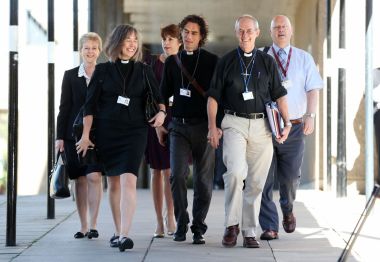Women bishops: What happens next?

Yesterday was a revolutionary day for the Church of England, as the General Synod voted to approve women bishops. The first female could be in office by the beginning of next year. So what's next? Who are the likely candidates? And will the Church, which has at times fought so bitterly over this, be able to remain unified now the vote is over?
Before the vote, Archbishop Justin Welby, who has been vocal in his support of women bishops (he told the Andrew Marr show that "theologically the Church has been wrong" on the matter) called for unity in disagreement, and "radical belonging". Those present remarked that his address was full of grace, and served to reinstate the familial, peaceful atmosphere that had been somewhat lost as tensions mounted in York during the afternoon.
Despite Archbishop John Sentamu asking for the results to be greeted with "restraint and sensitivity", however, as the announcement was read celebratory cheering reportedly erupted.
In a statement released yesterday evening, Welby said he is "delighted" by Synod's decision, while also being "mindful of those within the Church for whom the result will be difficult and a cause of sorrow".
"The challenge for us will be for the Church to model good disagreement and to continue to demonstrate love for those who disagree on theological grounds. Very few institutions achieve this, but if we manage this we will be living our more fully the call of Jesus Christ to love one another," he continued.
"Today marks the start of a great adventure of seeking mutual flourishing while still, in some cases disagreeing."
Women and the Church (WATCH) said its members were "overjoyed" following the agreed change in legislation. "This marks a new beginning for the church that can now begin to be fully affirming of both the women and men in it".
"What a historic day. Relief and then joy and then excitement. Yes to women at last," added chair Hilary Cotton.
As expected, however, yesterday's landmark decision was not met with such enthusiasm from all groups. The Catholic Group in General Synod noted in a statement "concern about the consequences for the wider unity of the whole church," though it also praised "the spirit of reconciliation" that pervaded the announcement and "the clear recognition that the introduction of women bishops is set within a broader process of discernment within the Anglican Communion and the whole Church of God".
While emotions are still running high less than 24 hours after the motion passed in all three Houses, thoughts are already turning to who will be elected to the position of first female bishop in the Church of England.
According to the Guardian, there are about 20 eligible women – most notably, perhaps, dean of York Vivienne Faull, June Osborne of Salisbury Cathedral and Jane Hedges of Norwich. Durham University Chaplain Miranda Threlfall-Holmes's name has also been thrown into the mix, along with Lucy Winkett, currently Rector of St James's Piccadilly, who – aged just 46 – is one of the younger potential candidates.
It's possible that the first female bishop may be appointed from a pool of Archdeacons, which include Rachel Treweek of Hackney and Jan McFarlane of Norwich, who – again according to the Guardian's sources – are already being "discussed" behind the scenes.
It remains unclear as yet, however, just who will be elected, though whoever it is will surely face further obstacles from those opposing the change in Church law. When Winkett was first appointed to her previous position as Canon at St Paul's Cathedral, the Chancellor at the time boycotted her first service, describing her position as "typical of the liberal agenda".
The first possible appointment will be the bishop of Gloucester, who is to be chosen in January 2015 after Michael Perham steps down this November. Canon Nikki Arthy of Gloucester Cathedral told the BBC that a female bishop would be "hugely welcome" following Perham's departure.
If not Gloucester, the bishops of Oxford and Newcastle are also set to retire before the end of this year, though it is not yet known when their successors are due to be announced. Due to the lengthy legislative process, however, the earliest a woman could be instated into the synod's house of bishops is summer 2015.
But regardless of who and where, there will no doubt be a woman bishop in place in the foreseeable future, which for many will not be a moment too soon.











